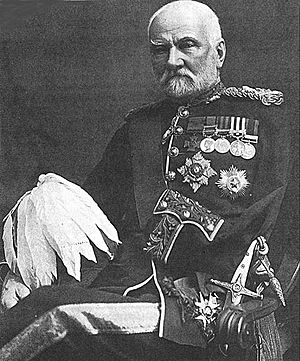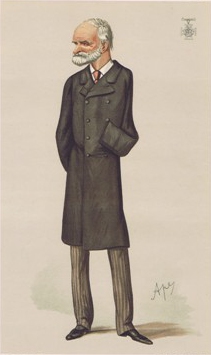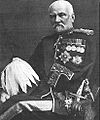Sam Browne facts for kids
Quick facts for kids
Sir Samuel Browne
|
|
|---|---|

General Browne in 1897
|
|
| Born | 3 October 1824 Barrackpore, British India |
| Died | 14 March 1901 (aged 76) Ryde, Isle of Wight |
| Buried |
Town Cemetery, Ryde
|
| Allegiance | |
| Service/ |
Bengal Army British Indian Army |
| Years of service | 1840–1901 |
| Rank | General |
| Battles/wars | Second Anglo-Sikh War Indian Mutiny Second Anglo-Afghan War |
| Awards | Victoria Cross Order of the Bath Order of the Star of India |
| Other work | Inventor of the Sam Browne belt |
General Sir Samuel James Browne (born October 3, 1824 – died March 14, 1901) was a brave officer in the British Indian Army. He was a cavalry officer, meaning he fought on horseback. He is most famous for inventing the Sam Browne belt, a special type of belt worn by soldiers.
Sir Samuel Browne also received the Victoria Cross. This is the highest award for bravery a soldier can get in the British and Commonwealth forces. It is given for amazing acts of courage during battle.
Contents
Early Life and Military Start
Samuel Browne was born in Barrackpore, India, in 1824. His father, Dr. John Browne, was a surgeon. Samuel went to school in England.
In 1840, when he was 16, he returned to India. He joined the 46th Bengal Native Infantry as an ensign. An ensign was a very junior officer rank.
Early Battles in India
Samuel Browne fought in the Second Anglo-Sikh War. This war took place in India. He was part of important battles like Ramnuggar and Gujrat.
In 1849, he became a lieutenant. He was given the job of creating a new cavalry group. This group was called the 2nd Punjab Irregular Cavalry. Later, this unit was named the 22nd Sam Browne's Cavalry in his honor.
Bravery in the Indian Mutiny
Browne led the 2nd Punjab in many fights. He was recognized for his bravery during the Bozdar Expedition in 1857. Because of his actions, he was promoted to captain.
Victoria Cross Award
Samuel Browne earned the Victoria Cross on August 31, 1858. This happened at a place called Seerporah in India. He showed incredible courage during a fight.
He rode forward with just one soldier towards a large enemy gun. This gun was firing at his advancing infantry. He attacked the gunners to stop them from reloading.
During this brave act, he was badly injured. He received a deep sword cut on his left knee. Soon after, another sword cut completely cut off his left arm at the shoulder. But even with these terrible injuries, he managed to fight off one of his attackers.
Because of his actions, the enemy gun could not be reloaded. It was later captured by his infantry. His Victoria Cross is now on display at the National Army Museum in London.
The Famous Sam Browne Belt
After losing his arm, Samuel Browne found it hard to wear his officer's sword. Swords were usually hung from a belt around the waist. With only one arm, this was difficult.
So, he created a special belt to help him. This belt is now known as the Sam Browne belt. It is a wide leather belt that goes around the waist. It has an extra strap that goes diagonally over the right shoulder. This diagonal strap helps to keep a sword steady and balanced.
Other officers in India who knew Browne started using his belt. It became very popular. Later, the British Army adopted it for many of its officers. General Browne's original Sam Browne belt is kept at the National Army Museum.
Later Career and Retirement
After the Indian Mutiny, Browne continued to serve in the Indian Army. He was promoted to major-general in 1870. In 1876, he became a Knight Commander of the Order of the Star of India. This was a high honor.
Leading in the Afghan War
From 1878 to 1879, Browne commanded a force during the Second Anglo-Afghan War. He led his troops through the Khyber Pass into Afghanistan. They defeated the Afghan army at the battle of Ali Masjid.
He occupied the city of Jalalabad. His advance towards Kabul was slow because of problems with transport. After the war ended, his force returned to India.
For his service in Afghanistan, he received more honors. He was made a Knight Commander of the Order of the Bath. Both the British Parliament and the Indian government thanked him.
Retirement and Legacy
Samuel Browne retired from active service in 1884. He was promoted to general in 1888. In 1891, he received the highest honor, Knight Grand Cross of the Order of the Bath.
He lived in Ryde, on the Isle of Wight, England, after retiring. He passed away there in 1901 at the age of 76.
There are memorials to Sir Samuel Browne in several places. These include the Ryde New Cemetery, St Paul's Cathedral in London, and Lahore Cathedral in Pakistan.
Images for kids




